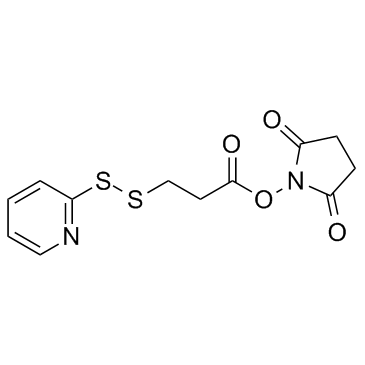SPDP

SPDP structure
|
Common Name | SPDP | ||
|---|---|---|---|---|
| CAS Number | 68181-17-9 | Molecular Weight | 312.365 | |
| Density | 1.5±0.1 g/cm3 | Boiling Point | 465.9±55.0 °C at 760 mmHg | |
| Molecular Formula | C12H12N2O4S2 | Melting Point | 84-86 °C(lit.) | |
| MSDS | Chinese USA | Flash Point | 235.6±31.5 °C | |
|
Optical fiber nanotips coated with molecular beacons for DNA detection.
Sensors (Basel.) 15 , 9666-80, (2015) Optical fiber sensors, thanks to their compactness, fast response and real-time measurements, have a large impact in the fields of life science research, drug discovery and medical diagnostics. In recent years, advances in nanotechnology have resulted in the ... |
|
|
Immunoliposomes containing Soluble Leishmania Antigens (SLA) as a novel antigen delivery system in murine model of leishmaniasis.
Exp. Parasitol. 146 , 78-86, (2014) Development of new generation of vaccines against leishmaniasis requires adjuvants to elicit the type and intensity of immune response needed for protection. The coupling of target-specific antibodies to the liposomal surface to create immunoliposomes has app... |
|
|
Evaluation of cathepsin B activity for degrading collagen IV using a surface plasmon resonance method and circular dichroism spectroscopy
J. Pharm. Biomed. Anal. 95 , 47-53, (2014) Evaluation of cathepsin B activities for degrading collagen IV and heat-denatured collagen IV (gelatin) were performed by surface plasmon resonance (SPR) and circular dichroism (CD) measurements. The optimal pH of cathepsin B activity for degrading each subst... |
|
|
Blood-brain barrier permeable gold nanoparticles: an efficient delivery platform for enhanced malignant glioma therapy and imaging.
Small 10(24) , 5137-50, (2014) The blood-brain barrier (BBB) remains a formidable obstacle in medicine, preventing efficient penetration of chemotherapeutic and diagnostic agents to malignant gliomas. Here, a transactivator of transcription (TAT) peptide-modified gold nanoparticle platform... |
|
|
MRI virtual biopsy and treatment of brain metastatic tumors with targeted nanobioconjugates: nanoclinic in the brain.
ACS Nano 9 , 5594-608, (2015) Differential diagnosis of brain magnetic resonance imaging (MRI) enhancement(s) remains a significant problem, which may be difficult to resolve without biopsy, which can be often dangerous or even impossible. Such MRI enhancement(s) can result from metastasi... |
|
|
Tracking targeted bimodal nanovaccines: immune responses and routing in cells, tissue, and whole organism.
Mol. Pharm. 11(12) , 4299-313, (2014) Dendritic cells (DCs) are the most potent antigen-presenting cells (APCs), involved in the induction of immunity and currently exploited for antitumor immunotherapies. An optimized noninvasive imaging modality capable of determining and quantifying DC-targete... |
|
|
A Humanized Anti-CD22-Onconase Antibody-Drug Conjugate Mediates Highly Potent Destruction of Targeted Tumor Cells.
J. Immunol. Res. 2015 , 561814, (2015) Antibody-drug conjugates (ADCs) have evolved as a new class of potent cancer therapeutics. We here report on the development of ADCs with specificity for the B-cell lineage specific (surface) antigen CD22 being expressed in the majority of hematological malig... |
|
|
Immobilization of FLAG-Tagged Recombinant Adeno-Associated Virus 2 onto Tissue Engineering Scaffolds for the Improvement of Transgene Delivery in Cell Transplants.
PLoS ONE 10 , e0129013, (2015) The technology of virus-based genetic modification in tissue engineering has provided the opportunity to produce more flexible and versatile biomaterials for transplantation. Localizing the transgene expression with increased efficiency is critical for tissue... |
|
|
Ribosome nascent chain complexes of the chloroplast-encoded cytochrome b6 thylakoid membrane protein interact with cpSRP54 but not with cpSecY.
J. Bioenerg. Biomembr. 47 , 265-78, (2015) We analysed the interplay between the cpSecY, cpSRP54 and the chloroplast-encoded cytochrome b6 via isolation of chloroplast ribosome nascent chain complexes and the use of cross-linking factors, antibodies and mass spectroscopy analyses. We showed that the c... |
|
|
In situ allicin generation using targeted alliinase delivery for inhibition of MIA PaCa-2 cells via epigenetic changes, oxidative stress and cyclin-dependent kinase inhibitor (CDKI) expression.
Apoptosis 20 , 1388-409, (2015) Allicin, an extremely active constituent of freshly crushed garlic, is produced upon reaction of substrate alliin with the enzyme alliinase (EC 4.4.1.4). Allicin has been shown to be toxic to several mammalian cells in vitro in a dose-dependent manner. In the... |